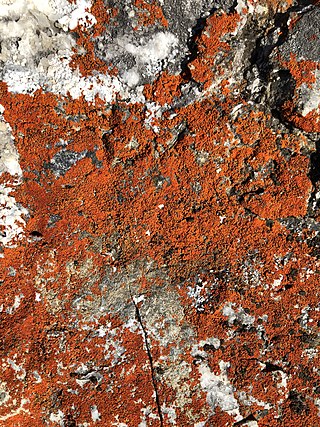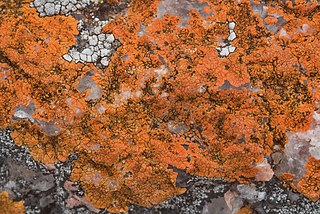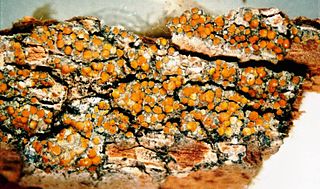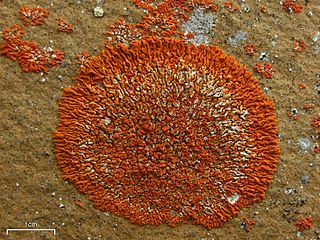
The Teloschistaceae are a large family of mostly lichen-forming fungi belonging to the class Lecanoromycetes in the division Ascomycota. The family has a cosmopolitan distribution, although members occur predominantly in subtropical and temperate regions. Most members are lichens that either live on rock or on bark, but about 40 species are lichenicolous – meaning they are non-lichenised fungi that live on other lichens. Many members of the Teloschistaceae are readily identifiable by their vibrant orange to yellow hue, a result of their frequent anthraquinone content. The presence of these anthraquinone pigments, which confer protection from ultraviolet light, enabled this group to expand from shaded forest habitats to harsher environmental conditions of sunny and arid ecosystems during the Late Cretaceous.
Fulgogasparrea decipioides is a species of lichen in the family Teloschistaceae. It is found in Gangwon Province, South Korea. This species was originally described in 2011by Ulf Arup as a member of the large genus Caloplaca. The specific epithet decipioides refers to its similarity with Caloplaca decipiens. Arup and colleagues transferred it to genus Wetmoreana in 2013, before it was again transferred to Fulgogasparrea that same year, a genus in which it is the type species.

Gyalolechia is a genus of lichen-forming fungi belonging to the family Teloschistaceae. It contains 18 species of crustose lichens.

Calogaya is a genus of lichen-forming fungi belonging to the family Teloschistaceae. It has 19 species. The genus was circumscribed in 2013 by Ulf Arup, Ulrik Søchting, and Patrik Frödén. The generic name Calogaya honours Dr. Ester Gaya, a Spanish botanist from the University of Barcelona.

Flavoplaca is a genus of crust-like or scaly lichens in the family Teloschistaceae. It has 28 species with a mostly Northern Hemisphere distribution.

Xanthocarpia is a genus of mostly crustose lichens in the family Teloschistaceae. It has 12 species with a largely Northern Hemisphere distribution.

Igneoplaca is a genus in the subfamily Xanthorioideae of the family Teloschistaceae. It contains a single species, the crustose lichen Igneoplaca ignea.

Fulgogasparrea is a genus of crustose lichens in the subfamily Xanthorioideae of the family Teloschistaceae. It has five species. The genus was circumscribed in 2013, with Fulgogasparrea decipioides assigned as the type species; this lichen had originally been formally described as a species of Caloplaca, and then a couple of years later transferred to Wetmoreana. Six are credited with authorship of the genus: Sergey Kondratyuk, Jeong Min-hye, Ingvar Kärnefelt, John Alan Elix, Arne Thell, and Jae-Seoun Hur. The genus name alludes to the resemblance of the type species with both of the Teloschistaceae genera Fulgensia and Gasparrinia.

Squamulea is a genus of lichen-forming fungi in the family Teloschistaceae. It has 15 species. The genus was circumscribed in 2013 by Ulf Arup, Ulrik Søchting, and Patrik Frödén, with Squamulea subsoluta assigned as the type species. Five species were included in the original account of the genus. The genus name alludes to the squamulose growth form of most of its species. Squamulea has a worldwide distribution; when the genus was originally created, the centre of distribution was thought to be in southwestern North America.

Cerothallia is a genus of crustose lichens in the family Teloschistaceae. It has four species, all of which occur in the Southern Hemisphere. The genus was circumscribed in 2013 by Ulf Arup, Patrik Frödén, and Ulrik Søchting, with Cerothallia luteoalba assigned as the type species. The type is more widely distributed, as it is also found in Europe and North America. The generic name Cerothallia means "with waxy thallus".
Sirenophila is a genus of crustose lichens in the subfamily Teloschistoideae of the family Teloschistaceae. It has four species with an Australasian distribution.
Huneckia is a genus of crustose lichens in the subfamily Caloplacoideae of the family Teloschistaceae. It has four species.

Wetmoreana is a genus of lichen-forming fungi in the family Teloschistaceae. It has two crustose, saxicolous (rock-dwelling) species.

Niorma is a genus of lichen-forming fungi in the family Teloschistaceae. It has six fruticose species, with N. derelicta assigned as the type species. The genus was originally proposed by Italian lichenologist Abramo Bartolommeo Massalongo in 1861, but this and several other genera he proposed were largely ignored by later contemporaries. As part of a molecular phylogenetics-led restructuring of the teloschistoid clade of the subfamily Xanthorioideae in the Teloschistaceae, Sergey Kondratyuk and colleagues resurrected the genus for use about 150 years later. Genus Niorma comprises what was previously known as a species complex centred around the taxon previously known as Teloschistes hypoglaucus.

Rusavskia is a genus of lichen-forming fungi in the family Teloschistaceae. It has 12 species. It is a member of the subfamily Xanthorioideae. The thallus of Rusavskia is characterized by its foliose (leaf-like) structure with distinct and typically narrow lobes that curve outwards.
Sirenophila eos is a species of saxicolous (rock-dwelling), crustose lichen in the family Teloschistaceae. It was first formally described as a new species in 2007 by Sergey Kondratyuk and Ingvar Kärnefelt, as Caloplaca eos. The type specimen was collected from rhyolite outcrops in New South Wales. Ulf Arup and colleagues transferred the taxon to the newly circumscribed genus Sirenophila in 2013, following a molecular phylogenetics-based restructuring of the Teloschistaceae.
Marchantiana is a genus of lichen-forming fungi in the family Teloschistaceae. It contains seven species of corticolous (bark-dwelling), crustose lichens that occur in the Southern Hemisphere.
Orientophila is a genus of lichen-forming fungi in the family Teloschistaceae. It has 15 species of mostly saxicolous (rock-dwelling), crustose lichens. All Orientophila species occur in Northeast Asia including China, Japan, South Korea, and the Russian Far East.
Elixjohnia gallowayi is a species of saxicolous (rock-dwelling), crustose lichen in the family Teloschistaceae. It has a vividly coloured thallus, ranging in hues from bright red to reddish-orange. It is found in Australia.
Elixjohnia jackelixii is a species of saxicolous (rock-dwelling), crustose lichen in the family Teloschistaceae. It is found in Australia and New Zealand. The lichen is characterised by its unique multilayered appearance with outer sterile rings that are brownish or greenish-yellow and inner areoles that are whitish, yellowish, or greyish, often cracked to reveal the medulla underneath. Its fruiting bodies, or apothecia, are typically attached directly to the thallus and vary in colour and shape.











